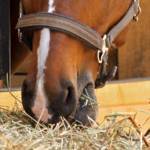Temporomandibular Joint Irritation in Horses

One of the most recent topics of popular concern among horse owners is the TMJ, or temporomandibular joint. TMJ irritation is being blamed for lameness, weight loss, head tossing, resistance, and a host of other problems.
The TMJ is the structure that allows a horse to open and close its mouth, so it is moved many times during an average day as the horse grazes, eats hay or grain, chews fences, rips off another horse’s halter, and settles down to do some mutual grooming with its favorite pasture buddy. In other words, the TMJ moves a lot, and it is designed to accept frequent movement without developing a problem. While TMJ ailments in humans are fairly common, similar conditions in horses are quite rare.
Studies in mice have shown that induced joint inflammation has more of an effect on hock and stifle pain and cellular changes, while the TMJ in mice showed much lower levels of these signs. It was hypothesized that equines might react similarly to the mouse models.
To test the effect of joint inflammation in equines, researchers injected an irritant into the TMJ and one fetlock joint on each of a group of horses. Saline was injected into another fetlock joint to serve as a control. Synovial fluid samples were taken in the next 24 hours and were examined for enzymes indicating inflammation. All irritant-injected joints were found to be tender, warm, and swollen. Horses showed pain and lameness on the irritated fetlocks, but there was no effect on feeding behavior and chewing, indicating that horses continued to eat even though the action should have caused pain. The conclusion was that inflammation in the TMJ appears to subside more quickly than in other joints. TMJ disease therefore is probably rare in horses, and it is somewhat unlikely to be an exclusive or significant cause of most lameness or behavioral problems.
Owners should not assume that TMJ discomfort is responsible for the signs their horse is showing, and should request an examination by a veterinarian if pain, discomfort, or inflammation is suspected.








